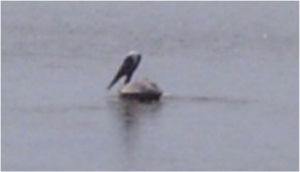Pelecanus occidentalis
Brown Pelican - Pelecanus occidentalis
Habitat: Brown Pelicans live in all habitats on the Pacific, Atlantic, and Gulf coasts. These birds are strictly coastal.
Geographical Range: Pacific, Atlantic, and Gulf coasts north to Nova Scotia
Ecological Notes: All pelicans have bills that are as long or longer than their heads. The huge naked skin pouch suspended from the lower half of the hooked bill holds two or three times more than the bird's stomach-about 3 gallons of water and fish. Pelicans hold their catch and let the water drain from the corners of their mouths before they swallow. Fish are never carried in the pouch, but in the gullet or esophagus. The pouch, besides acting as a dip net, is also pulsated in extreme heat to allow cooling. Pelicaniformes are the only birds that share in common a totipalmate foot, that is, one in which all four toes, including the hind one, are united by a web of skin. They are exceptionally buoyant due to the internal air sacks beneath their skin and in their bones.
Journal Articles: The Brown Pelican populations in many areas were severely damaged if not completely wiped out by DDT poisoning. For more information on the detrimental effects of DDT and it’s components on Brown Pelicans click the link below. http://journals.ohiolink.edu/ejc/tiff2pdf.cgi/Blus_Lawrence_J.pdf?issn=02697491&issue=v95i0001&year=1997&article=67_coeodomasoae Blus, L. J., Wiemeyer, S. N., & Bunck, C. M. (1997). Clarification of Effects of DDE on Shell Thickness, Size, Mass, and Shape of Avian Eggs. Environmental Pollution , 67-74.
So by now you probably think Brown Pelicans are either incredibly interesting or at least somewhat interesting. Are you thinking of visiting a Pelican nesting site to see these guys? You may want to check out the paper below. The paper covers ticks that invest Brown Pelican nests and the effects it has on nesting within Brown Pelicans as well as address the situation of human health within these infested nesting sites (the ticks carry infectious bacterial and viral agents). http://journals.ohiolink.edu/ejc/pdf.cgi/Reeves_Will_K.pdf?issn=01688162&issue=v39i3-4&article=321_bcaricoriscu Reeves, W. K., Loftis, A. D., Sanders, F., Spinks, M. D., Wills, W., Denison, A. M., et al. (2006). Borrelia, Coxiella, and Rickettsia in Carios capensis (Acari: Argasidae) from a brown pelican ( Pelecanus occidentalis) rookery in South Carolina, USA. Exp Appl Acarol , 321-329.
Personal Information: There were several Brown Pelicans spotted at Pea Island. They have a very unique feeding method. They dip their heads under the water and feel for fish with their beaks. Once a fish has been detected they snatch it up with their beaks and then “toss” it down their throats. Technically the fish could still be flopping around in their gullet, which would feel quite awkward to us.
Contributed by Whitney Barker - 2008
